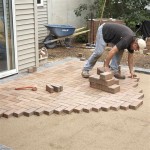How To Make a Concrete Slab Patio
A concrete slab patio provides a durable, versatile, and relatively low-maintenance outdoor living space. Constructing one requires careful planning, preparation, and execution. This article provides a comprehensive guide on how to build a concrete slab patio, covering various aspects from initial planning to final finishing.
Planning and Preparation: Setting a Solid Foundation
The success of a concrete patio hinges on meticulous planning. This phase involves evaluating the site, creating a detailed design, and gathering the necessary materials and tools. Overlooking any of these steps can lead to structural issues, aesthetic flaws, or increased costs later in the project.
Site Evaluation: Begin by assessing the existing ground conditions. Identify the presence of any underground utilities such as gas lines, water pipes, or electrical cables. Contacting the local utility companies is crucial to avoid accidental damage during excavation. Consider the existing slope of the land and how it will affect drainage. Ideally, the patio should slope away from the house to prevent water from pooling against the foundation. Note any existing vegetation that needs to be removed, including trees and shrubs, and their root systems.
Design and Layout: Determine the desired size and shape of the patio. Consider the intended use of the space, such as dining, lounging, or grilling. Larger patios may require expansion joints to control cracking. Mark the perimeter of the patio with stakes and string. Use a measuring tape and builder's square to ensure the layout is accurate and square. Consider the aesthetics of the surrounding landscape and how the patio will integrate with it. Software can be used to visualize the final product.
Permitting and Regulations: Check with the local building department to determine if permits are required for constructing a concrete patio. Some municipalities have specific regulations regarding setbacks from property lines, drainage requirements, and allowable impervious surfaces. Obtaining the necessary permits avoids potential fines and ensures compliance with local building codes.
Material Selection: Choose the appropriate concrete mix for your project. A standard mix for patios is typically a 4000 PSI (pounds per square inch) mix, which provides adequate strength and durability. Consider adding admixtures to the concrete to improve its workability, reduce cracking, or accelerate or delay the setting time. Select the type of reinforcing material to be used, such as wire mesh or rebar. Wire mesh is generally sufficient for smaller patios, while rebar is recommended for larger or more heavily loaded patios. Determine the type of base material to be used, such as gravel or crushed stone. The base material should be well-graded and compacted to provide a stable foundation for the concrete slab. Choose a finish that complements the design of the patio and provides adequate traction. Common finishes include broom finish, stamped concrete, and exposed aggregate.
Tool and Equipment Acquisition: Assemble the necessary tools and equipment before starting the project. This includes shovels, rakes, a wheelbarrow or concrete mixer, a tamper or plate compactor, a level, a screed board, floats, trowels, edgers, jointers, safety glasses, gloves, and knee pads. Renting specialized equipment, such as a concrete saw or a concrete mixer, can be a cost-effective option for larger projects.
Construction Process: Pouring and Finishing the Slab
The construction phase involves excavating the site, building the forms, pouring the concrete, and finishing the surface. This stage requires attention to detail and a systematic approach to ensure a structurally sound and aesthetically pleasing patio.
Excavation and Base Preparation: Remove any topsoil, vegetation, and debris from the marked area. Excavate the area to a depth that allows for the thickness of the base material and the concrete slab. The total depth will depend on the local frost line and the load-bearing capacity of the soil. A typical excavation depth is 6 to 8 inches. Compact the exposed soil using a tamper or plate compactor. This step is essential to prevent settling and cracking of the concrete slab. Add the base material, such as gravel or crushed stone, in layers of 2 to 4 inches. Compact each layer thoroughly before adding the next. The base material should be graded to provide a uniform thickness and a slight slope for drainage. A level and a long straightedge can be used to ensure the base is properly graded.
Form Construction: Build forms around the perimeter of the excavated area using lumber or flexible forming materials. The forms should be securely staked in place and leveled to ensure the concrete slab has a consistent thickness. The forms should be constructed to the desired height of the patio, taking into account the slope for drainage. Use a level to verify that the forms are level and aligned correctly. Apply a form release agent to the inside of the forms to prevent the concrete from sticking.
Reinforcement Installation: Place the reinforcing material, such as wire mesh or rebar, on top of the compacted base. The reinforcing material should be positioned in the middle of the concrete slab to provide maximum strength. Overlap the edges of the wire mesh or rebar by at least 6 inches and secure them together with wire ties. Use chairs or small pieces of concrete to elevate the reinforcing material off the base. This ensures that the concrete fully encapsulates the reinforcing material.
Concrete Pouring: Order the concrete from a reputable supplier and have it delivered to the site. Alternatively, mix the concrete on-site using a concrete mixer. Ensure that the concrete mix is consistent and has the proper slump. Pour the concrete into the forms, starting at one end and working your way to the other. Use shovels and rakes to distribute the concrete evenly within the forms. Avoid pouring excessive amounts of concrete in one area, as this can cause the forms to bow or break.
Screeding and Leveling: Use a screed board to level the concrete surface. The screed board should be long enough to span the width of the forms. Move the screed board back and forth across the forms to remove excess concrete and create a smooth, level surface. Fill in any low spots with additional concrete and repeat the screeding process. Check the surface with a level to ensure it is properly sloped for drainage. A slight slope of 1/4 inch per foot is generally sufficient.
Floating: After screeding, use a bull float or a hand float to smooth the surface of the concrete. The float should be held at a slight angle and moved in overlapping arcs. Floating closes the pores in the concrete and helps to bring fine particles to the surface. Avoid over-floating, as this can weaken the surface of the concrete.
Edging and Jointing: Use an edger to round the edges of the concrete slab. This prevents the edges from chipping and creates a more finished look. Run the edger along the inside of the forms, applying consistent pressure. Use a jointer to create control joints in the concrete slab. Control joints are shallow grooves that weaken the concrete, encouraging it to crack along these lines rather than randomly across the surface. Space the control joints according to the thickness of the slab. A general rule of thumb is to space them no more than 10 feet apart.
Finishing: Choose a finish that complements the design of the patio and provides adequate traction. A broom finish is a common and inexpensive option. To create a broom finish, drag a broom across the surface of the concrete while it is still slightly wet. Stamped concrete involves using rubber stamps to create patterns and textures on the surface of the concrete. Exposed aggregate involves removing the top layer of cement paste to reveal the decorative aggregate beneath. Follow the manufacturer's instructions for applying any sealers or coatings to the finished surface.
Curing and Maintenance: Ensuring Longevity
Proper curing is essential for maximizing the strength and durability of the concrete slab. Regular maintenance will help to keep the patio looking its best for years to come.
Curing Process: Curing involves keeping the concrete moist for several days after pouring. This allows the concrete to hydrate properly and develop its full strength. There are several methods for curing concrete, including: Covering the concrete with plastic sheeting. This prevents moisture from evaporating from the surface of the concrete. Spraying the concrete with water regularly. This keeps the surface moist and prevents it from drying out too quickly. Applying a curing compound. Curing compounds are liquid sealers that prevent moisture from evaporating from the concrete. Choose a curing method that is appropriate for the climate and the size of the patio. The curing process should last for at least 7 days, but longer curing periods are recommended in hot or dry weather.
Sealing: Applying a concrete sealer helps to protect the patio from stains, water damage, and freeze-thaw cycles. Choose a sealer that is designed for outdoor use and is compatible with the type of concrete finish. Clean the patio thoroughly before applying the sealer, removing any dirt, debris, or stains. Follow the manufacturer's instructions for applying the sealer, ensuring that it is applied evenly and in the proper thickness. Reapply the sealer every 1 to 3 years, depending on the type of sealer and the level of traffic.
Cleaning and Maintenance: Clean the patio regularly to remove dirt, debris, and stains. Sweep the patio regularly to remove loose debris. Wash the patio with soap and water to remove dirt and stains. Use a pressure washer to remove stubborn stains and mildew. Avoid using harsh chemicals or abrasive cleaners, as these can damage the concrete surface. Repair any cracks or damage to the concrete as soon as possible to prevent further deterioration. Fill cracks with a concrete patching compound and reseal the area.

How To Pour A Concrete Slab For Beginners Diy

How To Pour A Concrete Patio Easy Diy Instructions

Diy Concrete Patio In 8 Easy Steps How To Pour A Cement Slab

Concrete Pad For Beginners Diy

Quikrete Building A Concrete Patio

How To Prep Form Pour A Concrete Slab For Beginners Start Finish Youtube

How To Pour A Concrete Slab From Start Finish Diy Prep And

Resurfacing A Concrete Patio For Budget Diy Makeover Fab Everyday

Making Extra Large Concrete Pavers Diy Patio

Building A Diy Concrete Patio Step By Guide For Beginners








